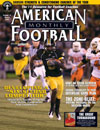Article CategoriesAFM Magazine
|
The Laboratory in the Skyby: Chris MatturaVeteran NFL Assistant Coach © More from this issue Most people think all the decisions in the National Football League are made from the sideline. Nothing could be further from the truth. I never worked on the sideline in the NFL. All my experience was in the coaches’ booth. I wouldn’t have had it any other way. The learning experience each game was priceless. I worked in the NFL coaches’ booth both offensively and defensively. The thinking process in the box is constant. You need to be zoned in on all cylinders for the entire game. The game you see on the field is a direct result of the analysis happening upstairs. From alerting the coordinators if a TV timeout is coming, to identifying an injury, the pace of activity “in the sky” never slows. Every coaches’ booth has a representative who is shooting the still photos of each play for the booth staff. They are shots of the entire field of play that are captured once the ball is snapped. Each team has a defensive coach who is charting the fronts and blitzes/dogs while another coach charts the coverages. At the end of every series, the stills are stapled together and the coordinator reviews them. I worked in many different capacities. I identified coverages verbally while also charting them. One offensive coordinator I worked for asked me to breakdown the pictures by offensive formations for first and second down to try to establish a defensive tendency by offensive personnel grouping and/or formation. In the NFL, third down is a different world. Those pictures have a meaning of their own. They are dissected vigorously. Most defensive coordinators have a third down philosophy, but the various distances the offense needs to make a first down makes it difficult to have a standard third-down defense. If you are in the right protection, you have a fighting chance. The key offensively is to gain four or more yards on first down and put yourself in a position to be successful on third down by not becoming predictable on second down. One coordinator who I learned a lot from was very aware of his run/pass ratio on first down in the slot formation. After each change of possession, he would always want his run/pass ratio itemized. In one game, he made the same call six times in a row on second down. We were successful on the first five. I told him to get off of that call - that the offense was going to hit the big one on us. After all, their coaches were getting paid, too. He called it again the sixth time and it resulted in one of our corners picking the ball off and taking it to the house. Rather than embarrass me, he said, “Keep talking to me.” He then said, “What would you do next if you were running their offense?” I said, “Get ready for the no-huddle.” Even though the time and score did not dictate no-huddle, we had stuffed everything else they threw at us. The no-huddle showed up on the next series but we were ready and continued with our attack mode. |
|
| HOME |
MAGAZINE |
SUBSCRIBE | ONLINE COLUMNISTS | COACHING VIDEOS |
Copyright 2024, AmericanFootballMonthly.com
All Rights Reserved




